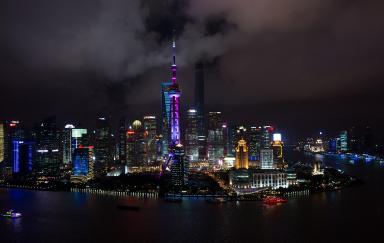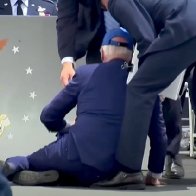A Preview of Your Chinese Future



Clouds above the Shanghai skyline on July 31, 2014.
Johannes Eisele/AFP/Getty Images
The year is 2049, one hundred years after the founding of the People’s Republic of China. The Belt and Road Initiative is complete. That does not mean it will stop or disappear. It is concluded in the same way a bridge or a road is built. Its development is finished, and it is ready to start working or operating at full power.
Some of the infrastructure projects are truly stunning and now stand as the highest example of what human ingenuity can achieve in its drive to master natural forces. A bridge crossing the Caspian Sea—125 miles, from Azerbaijan to Turkmenistan—has made road transport between Europe and China fast and easy, changing old mental maps that separated continents. The Kra Isthmus Canal in Thailand has done the same for the Indian and Pacific oceans. No longer do we think of them as two separate oceans. In Africa a high-speed railway connects the two coasts, traversing Djibouti, Ethiopia, South Sudan, the Central African Republic, and Cameroon in under twenty hours. Trade between Africa, Asia, and South America increasingly uses this route.
New cities have grown in once desolate or forbidding landscapes, many in Central Asia, Southeast Asia, and Africa. They have already gone through many stages of transformation: from logistics hubs ravaged by crime and corruption to booming metropoles attracting vast influxes of migrants and refugees spurned by the United States and the European Union, and then finally to economic powerhouses with low regulation, where successive technological revolutions take no more than a few years. Many of the new cities have sizable Chinese populations. These Chinese expats are the entrepreneurs and investment bankers, the trendsetters and technology prophets. Mandarin has largely replaced English as the international lingua franca.
This is how a Chinese world order might appear when looked from a distance—in our case, the distance of the past. But beyond its technical achievements, does China’s vision for the future still represent a recognizable world? Is it a break from the current world order in some fundamental way? Or is it still the world we live in today, only more balanced and more divided between different economic poles in Europe, Asia, and America—a continuation of the sort of globalization we have come to know?
Some observers believe the latter. In her own “speculative leap into Eurasia’s future,” Nadège Rolland describes a world where people do not “Google,” have a Facebook or Twitter account, or watch the news on CNN or the BBC. Instead, they “Baidu,” use Weibo for their social connections, and watch China Global Television Network. Children do not play “cowboys and Indians” but mimic the exploits of the Monkey King, one of their favorite heroes from the Journey to the West tale. The description is of course inspired by the existing world order and tries to project a future where China has replaced the United States, but the essential shape of things—institutions, values, and relations—remains largely unmodified. The differences are limited to what China lacks by contrast to the current ruler of the system; here, Rolland mentions freedom of speech and individual rights.
Similarly, Jonathan Holslag imagines a future Asian order replicating more or less perfectly the European order we know from the last few decades, with China occupying the core, as Germany and France do in Europe. The area from Shanghai to Chengdu and from Shenyang to Kunming has turned into a densely developed zone, saturated with the middle classes and boasting advanced industries, internationally renowned brands, and quality services. Fast trains and airlines channel millions of tourists to quiet or quaint places: to Tibet, emerging as the Chinese Pyrenees; to the Northeast, the future Chinese Alps; to Xinjiang, the new Andalusia; and to the southern beaches, China’s Mediterranean. China’s new multinationals have tied all other Asian countries to the motherland by means of roads, railways, pipelines, and financial flows. Japan’s fate could be compared to a depopulating version of the United Kingdom, quietly musing on its glorious past. Southeast Asia, China’s Italy, is vibrant and enthralling, yet heavily penetrated by Chinese companies, banks, and high livers. The stretch from Bangladesh to Kazakhstan could well be called China’s northern Africa and Middle East …
All this is unlikely. The kind of transformation China envisions would change everything. The system itself would be differently organized, and the goals and values inspiring it would be radically different. The new world would not be one where one piece on the chessboard would be replaced, nor even one where the pieces would be reorganized. It would be a world built anew by very different people and according to very different ideas.
David Rennie, Beijing bureau chief for The Economist, gets somewhat closer to the truth in his forecasting exercise, projected to 2024. Like Rolland, Rennie starts by imagining a dystopian negation of the West. China’s intelligence services, working with the country’s technology firms, have turned millions of cars in America, Europe, and Asia into remote spying devices, letting Beijing track vehicles in real time and identify passengers with facial-recognition technology. A new international organization, the Global Infrastructure Center, decides which schemes are eligible for billions of dollars in Chinese loans and grants, and picks foreign firms as partners using opaque rules devised by Communist Party planners.
But Rennie goes on to describe how the new Chinese-led global economic order is based on fundamentally different ideas and principles. New international courts have been created, and they draw no distinction between nations with state-directed and market economies. Its judges take a benign view of subsidies that claim to support national development and believe that sovereign governments, rather than individual businesses, should have the final say in patent disputes. “Rarely mounting direct challenges, China has instead tested, probed and introduced ambiguities into every aspect of global governance. Established powers have not so much acquiesced as proved too weary to resist.”
Still, dystopian frameworks are generally unhelpful when thinking about China’s rise. They are predicated on the supposition of a wholesale collapse of the Western political order, a scenario that seems unlikely at present and seems bound to remain unlikely. There are many reasons one cannot extrapolate from China’s extraordinary rise over the past four decades to the shape of future events and developments. First, the challenges China faces now during its continued rise will be fundamentally different in nature: political more than economic, with security concerns raising their ugly heads. Meanwhile, that very rise or expansion creates new variables—reactions, responses, changes of attitude—as other countries increasingly regard China as a threat or, at the very least, a competitor.
Moreover, our current historical juncture crucially differs from others in the sense that China’s rise does not depend on a technological breakthrough which will remain inaccessible to the West. This is the point where parallels with the corresponding moment in the 18th and 19th centuries—when the West rose to global preeminence—must stop. The new world order toward which we are moving is not one where there is a clear center, but rather one distinguished by the search for balance between different poles. So when we describe a new Chinese world order, we have to keep in mind there will be other shareholders, other shapers, and other balancers. The West will diminish in reach and influence, but 30 years from now it will continue to offer a powerful alternative to the Belt and Road Initiative, even if it may also be expected to evolve in response to the Chinese challenge..



The mindset of China and much of asia is quite different than that of the western world. It is not impossible to see the transformation taking place. Perhaps not as complete as descriped in the article but substantial none the less.
Or perhaps there will be two world orders the western and the asian..
It would also seem in addition to the Belt and Road project that they have set their sights on outer space.
China launches probe to explore dark side of Moon:
Who is this chick in the picture?
A victim of Trump and his enablers.